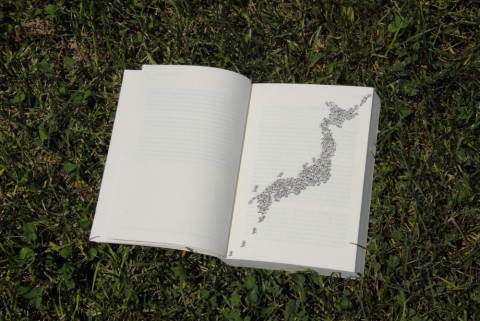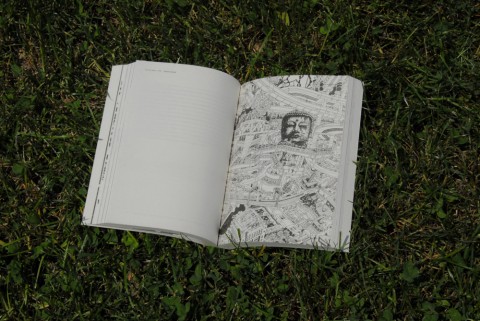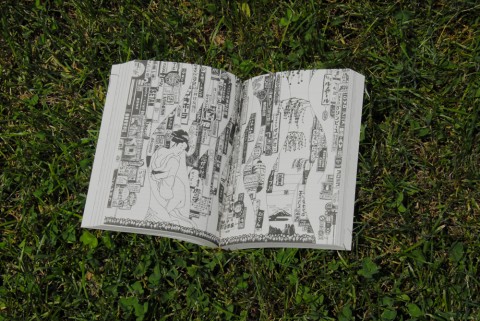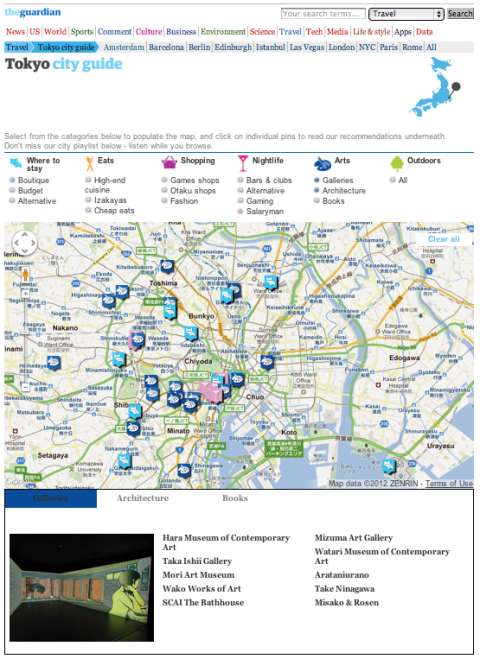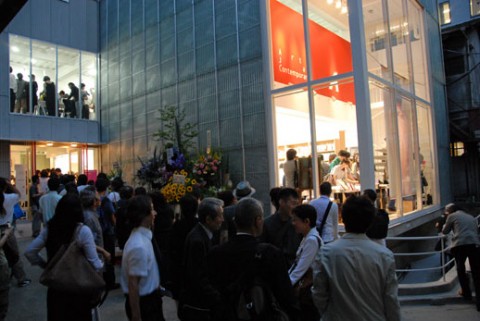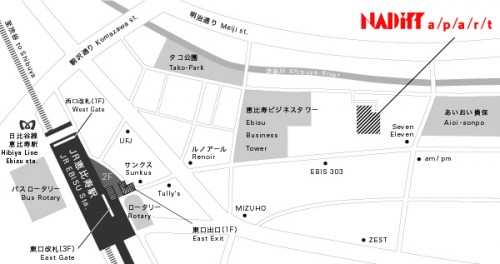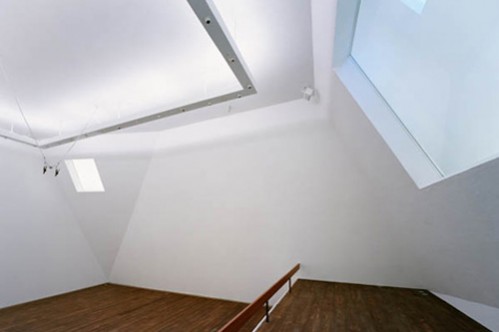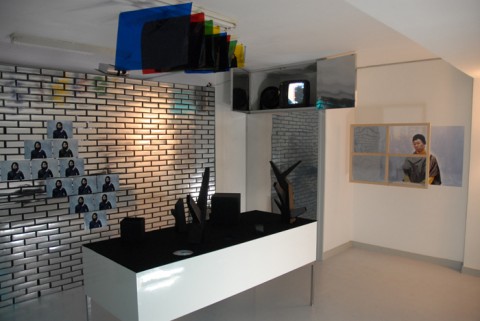Architecture
Nobumasa Takahashi Illustrates “Tokyo: Portraits and Fictions”
Takahashi Nobumasa, the artist who illustrated Art Space Tokyo, has provided some astounding work for a new book on Tokyo.
French architect Manuel Tardits’ Tokyo: Portraits and Fictions is a meditation on the urban planning and spatial culture of the Japanese capital. Reminiscent of Roland Barthes’ Empire of Signs (1970), the publication spans the genres of history book, travelogue, and architectural critique. Its 85 chapters are short, eulogistic streams of consciousness that cover concepts and narratives ranging from “Steps” to “Urashima Taro,” “Shadow,” “Ubiquity,” “Enclosures,” “Heroism,” and “Superflat.”
Architects are prone to flowery and overwrought writing, and the text in this book is no exception. What might be a bit of a rushed translation into English also seems to add to the awkwardness in some places. So while one could read the book from start to finish, it may be more pleasant to dip in to it at random intervals and digest it in morsels, one idea at a time.
Takahashi’s pen-and-ink illustrations are as always a playful array of crisp lines, wobbly protrusions, and dense compositions. In his hands, Tokyo is a web of silhouetted telephone lines, a cascade of neon shop signs, and a tangle of elevated expressways and railroads cradling the head of the Giant Buddha of Kamakura.
I was also pleased to discover the work of the book’s other illustrator, Stéphane Lagré, a French architect based in Nantes. His grainy photo-collages are an unnerving take on the city. One stands out in particular: a panorama of Tokyo in which Mount Fuji looms large on the horizon and nine white rings ominously encircle different areas of the city. They recall one of the early scenes in Katsuhiro Ohtomo’s Akira (1988), in which the nuclear explosion that destroys Tokyo is depicted as a rapidly expanding dome of light that consumes the metropolis.
Ten Best Galleries and Works of Architecture on The Guardian
The Guardian has just launched its Tokyo City Guide, a fantastic interactive look at the city that includes recommendations for the best restaurants, hotels, bars, and clubs. Their summary of typical salaryman hangouts is a great alternative look at life in Tokyo.
I was asked to contribute my ten favorite galleries and museums, and my ten favorite architectural highlights. All of these locations are marked on a Google map of the city that you can play with here. The top ten galleries and works of architecture also have their own separate pages if you want to read them without having to click between from one to the other.
New Gallery Building Opens in Ebisu
Earlier this week, the NADiff art bookstore, which vacated its Omotesando premises last summer, finally reopened its doors in Ebisu. The new building also houses three galleries — Magical Artroom, G/P Gallery and Art Jam Contemporary — as well as a new bar/café, Magic Room. I posted a photo report of the extremely crowded opening party here, on Tokyo Art Beat.
New Gallery Building to Open in Ebisu
This is the latest chapter in Tokyo’s ongoing series of gallery relocations of the past six months. The building will house Nadiff bookshop, Magical Artroom and G/P Gallery.
Nadiff, Tokyo’s number one art bookshop, left its main premises in Omotesando last summer, and since then has been running only its museum shop outlets. The Roppongi gallery building closed in February this year, forcing its occupants to find new locations throughout the city, and news spread that Magical Artroom would be joining Nadiff in Ebisu. However, the opening date for this new building has been repeatedly postponed since then.
Magical Artroom was previously operated by a collective of Tokyo art world figures — collector and psychiatrist Satoshi Okada, art critic Kentaro Ichihara, and editor Shigeo Goto, with Haruka Ito running the office. Now, Haruka Ito is running the gallery, with Satoshi Okada as president and Masami Shiraishi (director of SCAI The Bathhouse) as a professional adviser. The former directors will also remain as advisers.
Shigeo Goto also announced recently that he will also be opening his own photography gallery in the same building, called G/P Gallery.
The new building will open on July 7, 7pm.
Music for a Rainy Day at Jun Aoki’s Sonorium
On Sunday, I made two great discoveries. Taka Ishii Gallery was holding a music event in the name of the gallery’s magazine ‘Fun Palace’ at the Jun Aoki-designed concert hall “sonorium” in Eifukucho.
I had never heard of the sonorium before, so it was a fantastic surprise to walk into such a serene, white, chapel-like space, nestled into a residential area. If it were a gallery, there is no doubt that it would have been featured in Art Space Tokyo. Anyone want to make Music Space Tokyo?
Throughout Sunday afternoon, a listening session was held for a recording of Morton Feldman’s composition String Quartet No.2. As it was being played in its full six-hour length, visitors were allowed to come and go as they pleased, and I arrived for the last hour. While I enjoyed Feldman’s minimal musings enough, it was really the following live performance by Swedish musician David Wenngren (aka “Library Tapes") that was so breathtaking.
Wenngren combines light, meditative piano chords and melodies with the hissing and humming static of field recordings. Against this gentle white noise, uplifting sweeps of strings work their way into his compositions — the perfect soundtrack for the pouring rain outside. You can hear plenty of sample tracks on his MySpace and Virb.com pages. I also recommend that any music and architecture lovers in Tokyo check out the sonorium.
‘Fun Palace’ is also an interesting bilingual journal of articles and interviews relating to contemporary art in its broadest sense, transcending genres. You can pick up the first issue at Taka Ishii Gallery, and the second issue, which will focus on dance, is due to be released this summer.
Art and Architecture Revamp Shibuya Station
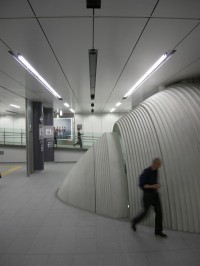 It’s not often that you get to experience the smell of a new subway station, or feel happy to miss several trains while you wander around the platform staring at the architecture. Beijing will be unveiling its new subway lines for the Olympics in a couple of months, but right now, the Fukutoshin Line, opened in Tokyo over the weekend, is the world’s newest.
It’s not often that you get to experience the smell of a new subway station, or feel happy to miss several trains while you wander around the platform staring at the architecture. Beijing will be unveiling its new subway lines for the Olympics in a couple of months, but right now, the Fukutoshin Line, opened in Tokyo over the weekend, is the world’s newest.
Designed to alleviate rush hour congestion on the western edge of the JR Yamanote Line, it runs from Shibuya up to Ikebukuro, and then up into Saitama Prefecture. In 2012 the current Shibuya terminus will connect to the Tokyu Toyoko Line, making it much easier to move between Saitama and Kanagawa prefectures.
The Shibuya Station end of the Fukutoshin Line has been designed by the master of concrete architecture Tadao Ando, who has integrated a large, vaulted ovoid structure into the center of the station — dubbed an “underground spaceship” — which makes for both a striking journey to and from the platforms, and allows for the free flow of air in and out of the station. Needing no fans for circulation, this is the world’s first naturally ventilated subway station.
Meanwhile, earlier this year the concourse between the JR Yamanote Line and the Inokashira Line was chosen as the permanent location for Taro Okamoto’s 30 meter-long mural The Myth of Tomorrow. The work has had something of a fraught history, detailed here on Tokyo Art Beat, and will finally settle into its permanent home in Shibuya in 2011.
“Absent City” Held at Gallery Within Assistant
Architectural unit assistant, run by Megumi Matsubara and Hiroi Ariyama, have started to hold a series of exhibitions titled “Absent City”. The first installment is being held at their studio space in Hatsudai, named “gallery within assistant” for these exhibitions.
The exhibition is presented as a memoir of Tokyo as an “absent” space that doesn’t exist. Seven portraits have been taken on the streets of Tokyo, and recordings of conversations with each of these people are being broadcast through the gallery. With the handheld radio you are given at the entrance, the soundtrack to this exhibition shifts from white noise to clarity and back again as you move towards and away from the images. In the middle of the room is a table inside of which is an elaborately constructed, abstract miniature of a city, which you are only able to peer at through a set of prisms and peepholes.
The show ends June 12 (TAB details here), but there are others planned, and as soon as news of the next one comes in, it will be announced on this blog.
For anyone in Paris, it’s worth noting that assistant are the people behind the “Galerie des Galeries” exhibition space currently installed in Galeries Lafayette.
About & Community
A place to keep abreast of Art Space Tokyo related news, reviews, events and updates.
Art Space Tokyo is a 272 page guide to the Tokyo art world produced and published by Craig Mod & PRE/POST.
It was originally published in 2008 by Chin Music Press.
Current Tokyo exhibitions
Powered by Tokyo Art Beat

